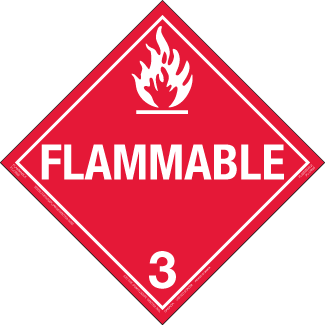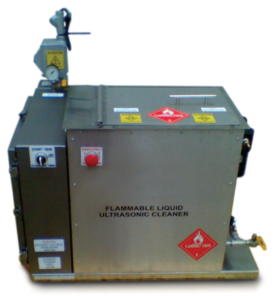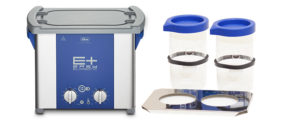How to Safely Clean Surgical Implants with IPA
Strict guidelines apply to the cleanliness of surgical implants to assure there are no residual contaminants that can cause infection or other issues after patients are discharged. A very effective cleaning solvent for surgical implants is isopropyl alcohol (IPA). This is because it evaporates quickly, is relatively non-toxic and, importantly, dries residue free.
Ultrasonic cleaners are widely used for cleaning surgical implants after manufacturing because of their speed and effectiveness in removing contaminants. But using IPA in an ultrasonic cleaner requires special precautions and equipment because IPA is a flammable liquid.
This post describes how to safely clean surgical implants with IPA.
We’ll cover:
- A quick definition of flammable liquids
- Special considerations to safely clean surgical implants
- Defining a hazardous location
- Equipment selection suggestions
- Workplace precautions
Flammable Liquids Defined

Flammable liquids, also termed volatile solvents, are ranked by what is called their flash points. In brief, the lower the flashpoint the more flammable they are, which is an important consideration when specifying an ultrasonic cleaner for flammable liquids.
The American Chemical Society publishes a table of common organic solvents that includes flash points. Examples of low flash point volatile solvents are 1 propanol at 59⁰F, acetone at -4⁰F and toluene at 39⁰F. Solvents with higher flashpoints include NEP (N-ethyl-2-pyrrolidone) or NMP (N -Methyl-2-pyrrolidone) at or above 131˚F.
In chemical terms flash point is the temperature at which a particular organic compound gives off sufficient vapor to ignite in air when given an ignition source.
Special Considerations to Safely Clean Surgical Implants
In view of this, selection of a flammable liquid ultrasonic cleaner must take into account that not only do volatile solvents evaporate, the ultrasonic cleaning process generates heat that accelerates solvent evaporation and vapor generation.
Therefore, solvent evaporation is a critical consideration when selecting a flammable liquid ultrasonic cleaner.
Operating these units creates what the National Electric Code (NEC) defines as a hazardous location. Why? Because fumes or spilled solvents can be ignited by extraneous sources such as electrical equipment, associated wiring as well as an ultrasonic cleaner not certified as explosion proof.
Stringent precautions apply when dealing with fumes and possible spilled solvent in the workplace. These precautions are summarized later in this post.
Selecting a Flammable Liquid Ultrasonic Cleaner
There are several options available to use volatile solvents in an ultrasonic cleaner. For high-volume operations the SOL XP flammable liquid ultrasonic cleaning systems in 4 tank capacities from 4 to 33 gallon tank capacities are now available from Tovatech. These are designed to be used with low flash point volatile solvents.
These 40 kHz ultrasonic frequency units are compliant with all Class I, Division 1 (CI,D1) code and zone requirements. Different only in tank dimensions and capacities all offer an optional cooling jacket around the upper tank perimeter to capture solvent vapor and reduce odor.
These explosion proof ultrasonic cleaners carry an Intertek ETL Certification and are shipped with a remote electrical panel to be located outside the CI,D1 envelope. Units are nitrogen inerted for additional fire protection.
Other included and optional features can be found on Tovatech’s SOL XP flammable liquid ultrasonic cleaning systems page.
Low volume cleaning of surgical implants with IPA
If you need low volume or occasional need to clean surgical implants with IPA a solution is to isolate the solvent from the environment.
An example is using an Elmasonic E Plus ultrasonic cleaner in conjunction with a cleaning kit that allows you to clean surgical implants in a beaker.
Carefully place the implants in a beaker and add just enough IPA to ensure they are fully immersed.
Cover the container loosely to minimize the vapor escaping during the cleaning process. Containers should never be tightly sealed as expansion due to heat created by ultrasonic cavitation could cause them to break.
In this instance you can use tap water with a surfactant in the ultrasonic cleaning tank. Before proceeding remember to degas the water solution by operating the pulse mode for a few minutes.
Ultrasonic beaker kits are a great solution for this application.
Immerse the bottom 1-2 inches of the beakers the water. Ultrasonic energy will penetrate the glass walls and cleaning action will occur in the IPA. At the conclusion of the process carefully remove the surgical implants which, when dry, will be residue free.
Fire Safety Compliance when Using Flammable Solvents
As a general rule, whenever you install an ultrasonic cleaner for use with volatile solvents or modify a cleaner such as with a beaker kit as noted just above you must check with local public safety officials and your plant safety personnel to ensure compliance.
Your best overall source for compliance, in addition to your local and plant safety personnel, is the National Electric Code (NEC) and National Fire Protection Association Flammable and Combustible Liquids Code (NFPA 30). These address issues related to Class, Division and group, ventilation, electrical cord, plug, and receptacle. Check this link to NFPA 30 for more information on these issues.
Here are some basic suggestions:
- An explosion proof exhaust system should be positioned over the ultrasonic cleaner to draw off fumes and protect personnel from inhaling them.
- Check the unit and power cable for damage, and do not operate it if damage is visible.
- Periodically examine tank seals (if provided on the unit) for damage.
- Check the tank and enclosure for damage that could result in leakage.
- If your ultrasonic cleaner is equipped with a heater do not activate it.
- Follow instructions to maintain proper solvent level in the tank.
- Never operate the unit in the presence of a potential source of a spark.
- No personal electronics should be used in proximity to the cleaners.
More stringent regulations may apply depending on the flammable liquid ultrasonic cleaner you select. Please contact the scientists at Tovatech for expert advice on selecting the correct unit for your operations and information on code compliance.



